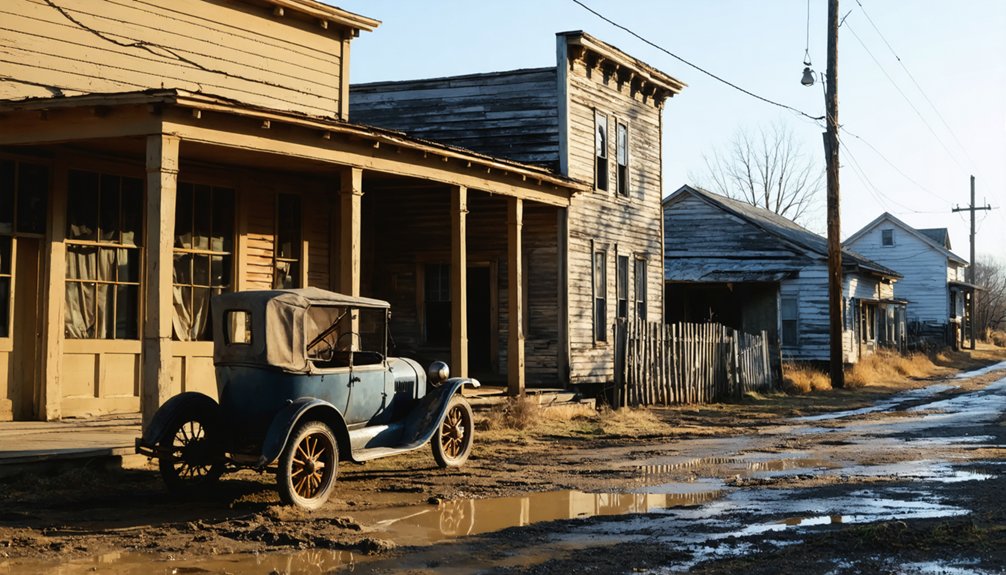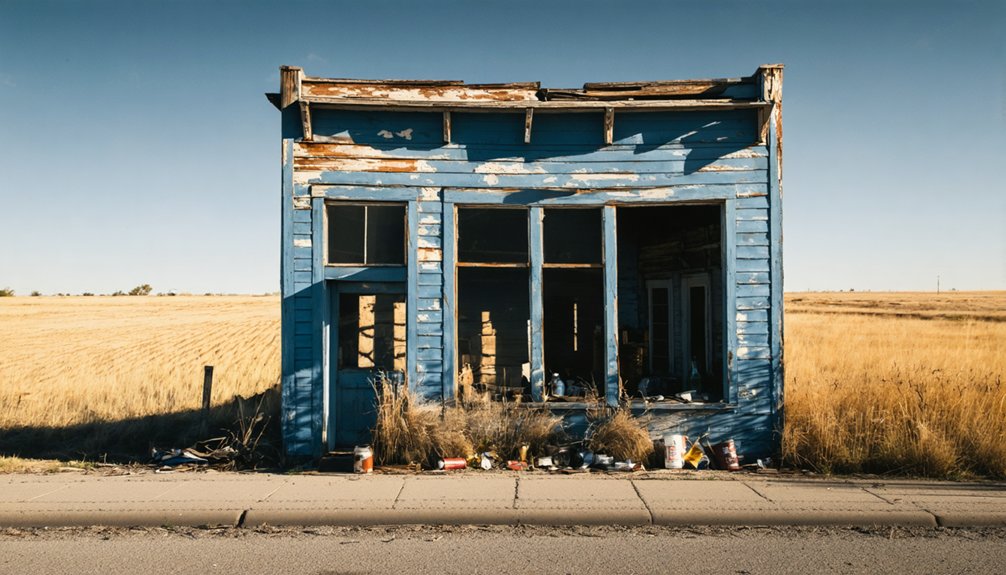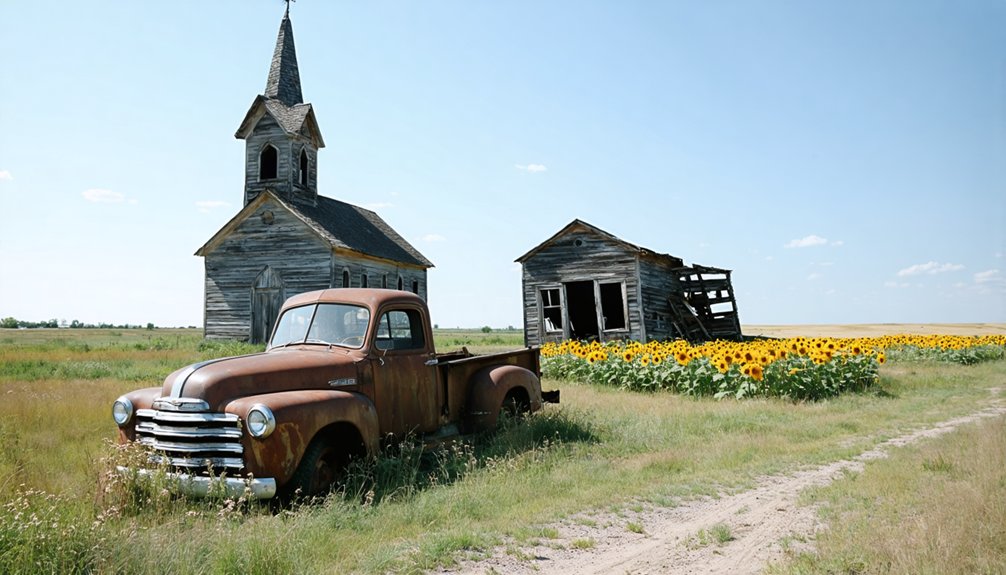You’ll find Castleville nestled along Castle Creek in South Dakota’s Black Hills, where prospectors first struck gold during the rush of 1874. The town grew from a small mining camp into a bustling community after the Chicago, Burlington & Quincy Railroad arrived in 1889. Its peak came in the early 1900s with the discovery of rich coal deposits, employing over 60 workers until 1969. Today, weathered ruins and mining shafts tell fascinating tales of this frontier settlement’s past.
Key Takeaways
- Castleville began as a Black Hills gold rush settlement in 1874, later transitioning from placer to hard rock mining operations.
- Originally named Sitting Bull, the town was renamed Mystic in 1889 when the Chicago, Burlington & Quincy Railroad arrived.
- The town’s economy centered on gold mining and coal production, with the Firesteel Coal Company operating until 1969.
- Cultural influences from Danish, Norwegian, and Dutch settlers shaped the community, with homes built using local wood and sod materials.
- Today, Castleville’s ruins include mining shafts, dredge barges, and foundational remains along Castle Creek, marking South Dakota’s frontier history.
The Rise of a Mining Town
While the Black Hills gold rush of 1874 spawned numerous mining settlements across South Dakota, Castleville emerged during this pivotal period when prospectors were moving from placer to hard rock mining.
You’ll find that like many towns in the region, it developed as miners exhausted the easily accessible gold in streams and began seeking the precious metal in deeper, more challenging locations.
Early prospectors relied on basic picks and shovels as they searched for gold deposits throughout the area.
As the town development progressed, you would’ve witnessed the shift from simple placer mining operations to more sophisticated hard rock extraction methods.
The evolution mirrored the broader changes happening throughout the Black Hills, where mining communities were establishing permanent infrastructure.
Though specific details about Castleville remain sparse, it was part of a larger economic transformation that brought thousands of fortune seekers to South Dakota’s rugged terrain.
The discovery of the Homestake Mine in 1876 revolutionized mining operations in the region, as it would eventually produce 10% of the world’s gold supply.
Life Along Castle Creek
You’ll find Castle Creek‘s earliest settlements formed during Custer’s 1874 Black Hills Expedition, with the small mining camp of Sitting Bull emerging in 1876 before being renamed Mystic in 1889.
Local folklore suggests the town’s new name reflected the area’s spiritual connection to the land, aligning with mystic traditions of the time.
The creek’s banks supported several mining operations, including the notable Fairview Mine and a ten-stamp mill that processed local ore by 1895.
When the Chicago, Burlington & Quincy Railroad reached Mystic in 1889, it transformed the area’s mining capabilities, though the town’s population never exceeded 100 residents. The Mystic Reduction Mill built in 1900 processed an impressive 150 tons of ore daily during its peak operations.
Creek Settlements and Industries
As Castle Creek carved its path through the Black Hills, it became the lifeblood of several thriving settlements following George Armstrong Custer’s 1874 expedition to the region.
You’ll find the earliest settlement, initially called “Sitting Bull,” emerged in 1876, later renamed Mystic when its post office opened in 1885. The creek’s banks soon bustled with industrial growth as the Chicago, Burlington & Quincy Railroad arrived in 1889, transforming these modest mining camps into hubs of commerce. Like many other locations in the region, this area evolved into one of the six hundred ghost towns that would eventually dot the Black Hills landscape.
Along the waterway, you’d have seen ten-stamp mills, the ambitious Mystic Reduction Mill, and numerous timber operations supporting the mining economy. The mill utilized innovative electro-cyanide process technology until its demolition in 1913.
Nearby Castleton briefly flourished as a railroad town, while innovative mining technologies like electro-cyanide extraction marked the area’s determination to harness the creek’s potential.
Mining Along Castle Creek
Following George Armstrong Custer’s expedition in 1874, the discovery of gold by geologists Walter Jenney and Henry Newton transformed Castle Creek into a bustling mining hub.
You’ll find that their discovery sparked the Black Hills Gold Rush, leading to the establishment of a small mining camp initially named “Sitting Bull” in 1876.
While placer mining kept the settlement operational, you can trace the area’s industrial growth through the ten-stamp mill established near Mystic by 1895.
Many prospectors abandoned the area for richer deposits in Deadwood, following the pattern seen throughout Pennington County’s early mining history.
Though the Mystic Reduction Mill‘s experimental electro-cyanide processes proved unsuccessful, the mining operations left an indelible mark on the landscape.
You’ll spot remnants of these activities today, from old mining structures to waste sites, evidence of an era when prospectors sought their fortunes in Castle Creek’s promising waters.
Railroad Development Impact
When railroad companies began planning routes through South Dakota in the 1880s, their decisions dramatically reshaped life along Castle Creek. You’d have witnessed entire communities, like Dakota City, picking up and moving to new locations just to stay connected to these essential transportation arteries.
The first steam locomotive arrived in the Midwest decades earlier in 1848, setting important precedent for western expansion. Railroad influence transformed isolated homesteads into bustling centers of commerce, with grain elevators and telegraph offices sprouting up around the tracks. Local speculators invested heavily in land near potential rail routes, hoping to profit from future development.
The town relocation phenomenon wasn’t unique to Castle Creek – across the region, communities lived or died by rail access. You’d find new settlements like Castlewood emerging in 1881-1882 along the Chicago and Northwestern line, while others faded into obscurity when bypassed.
The railroads didn’t just move goods and people; they revolutionized communication, bringing newspapers, mail, and telegrams to once-isolated settlers.
Mining Operations and Railroad Development
The discovery of rich coal deposits in the Firesteel coal fields sparked Castleville’s mining industry in 1907, beginning with Andrew Traversie and William Benoist’s small-scale excavations for personal use.
By 1911, Fred Hammersly and Charles Lindt transformed the area into a commercial operation, implementing shaft and drift mining techniques to access the region’s vast 137 million ton coal reserves. Similar to Homestake Mining Company‘s success, the local mines proved highly profitable despite their relatively low-grade deposits.
Hammersly and Lindt pioneered commercial coal mining in the region, unlocking access to massive underground reserves through innovative extraction methods.
You’ll find that Castleville’s mining prosperity peaked in 1942, producing over 53,000 tons of coal annually. The railroad network proved essential, enabling you to ship coal as far as Iowa.
The Firesteel Coal Company emerged as the dominant force, employing more than 60 workers during the 1920s. Despite wartime labor shortages and declining profits, mining operations persisted until 1969, leaving an indelible mark on Castleville’s landscape.
Daily Life in Early Castleville

Life in early Castleville revolved around a distinctive blend of prairie ingenuity and cultural adaptation.
You’d have found yourself living in a home built from local materials like wood and sod, with wattle and daub construction keeping you warm through harsh Dakota winters. Inside, you’d have stored your harvest and belongings in cache pits beneath the floor.
Your daily routine would’ve centered on agricultural practices, tending to gardens near the river’s fertile floodplain while maintaining connections with neighbors from diverse backgrounds.
Danish, Norwegian, and Dutch cultural influences shaped the community’s character. You’d have participated in the town’s growing economy, whether through farming, trading at the freight house, or working with local craftsmen.
The railroad kept you connected to wider markets, while schools and religious gatherings strengthened your community bonds.
The Legacy Left Behind
Today, Castleville’s weathered remnants tell stories of South Dakota’s bustling frontier past.
You’ll find foundational ruins, mining shafts, and the skeletal remains of dredge barges in Castle Creek, each marking the town’s cultural significance in the Black Hills’ gold rush era. The environmental impact of mining operations remains evident through tailings, dredge waste piles, and abandoned cyanide process vats.
As you explore the ghost town, you’ll discover how Castleville symbolizes the classic boom-and-bust cycle of frontier communities.
The site’s industrial heritage lives on through archaeological remnants, while local folklore adds layers of mystique to its history. From tales of ambitious prospectors to legendary outlaws, Castleville’s legacy continues to captivate those seeking connections to the untamed spirit of the American West.
Exploring the Ghost Town Today

You’ll find tangible evidence of Castleville’s mining past in the dredge pools and sunken barge ribs along Castle Creek, where early 1900s operations left their mark on the landscape.
While exploring the ghost town near the intersection of Mystic/Rochford Road and Castle Peak Road, you can follow unmarked trails that trace old stagecoach routes through the Black Hills.
The site’s scattered ruins, mining waste piles, and foundation remnants offer glimpses into the town’s railroad and mining heritage, though you’ll need to watch for hazards around unstable structures and excavation sites.
Mining Remnants Still Visible
While Castleville’s buildings have largely vanished, the scattered remains of its mining operations still dot the Black Hills landscape.
You’ll find imposing shaft houses and ore bins standing as evidence to the area’s mining architecture, with the Lookout Mine’s mill building on Castle Creek being particularly striking.
Nearby, you can trace elevated tramway supports up hillsides where ore once traveled to processing facilities.
The environmental degradation is equally visible.
You’ll encounter vast tailings piles forming barren badlands, stripped of vegetation.
Corroded cyanide vats still stand as stark reminders of historic extraction methods.
In Castle Creek, partially submerged dredging barges rust away, while abandoned ten-stamp mills, ore hoists, and winches reveal the impressive scale of mining technology that once dominated this rugged terrain.
Hidden Trails Worth Discovering
Beyond the rusted mining relics, a network of hidden trails beckons modern-day explorers to Castleville’s haunting remains.
You’ll find these trail stories etched into converted railroad grades and old stagecoach routes throughout the Black Hills terrain. As you navigate the gravel roads near Castle Creek, hidden treasures await – from sunken dredge barge ribs to scattered mill frames and tramway foundations.
While exploring these paths, you’ll encounter mixed conifer forests, seasonal wildflowers, and abundant wildlife typical of western South Dakota.
Pack your GPS and sturdy boots, as limited signage makes navigation challenging. Remember to respect private property boundaries and stick to established trails.
The remote location preserves both the ghost town ruins and natural paths, offering you glimpses into the region’s rich mining heritage.
Frequently Asked Questions
Is Castleville Accessible by Public Transportation?
No, you won’t find any public transit to Castleville. Your travel options are limited to driving your own vehicle or arranging private transportation through the rural Black Hills region.
Are There Any Dangerous Wildlife Encounters Reported in the Area?
You’ll find wildlife safety is well-maintained, with no documented dangerous encounters. While you might spot bison, elk, and mountain lions in surrounding Black Hills areas, attacks remain extremely rare.
What Months Offer the Best Weather Conditions for Visiting Castleville?
Like a warm embrace, May through early October offers your best visiting months, with summer’s dry spells and mild weather patterns. You’ll find peak conditions from June through early September.
Do Visitors Need Special Permits to Explore the Ghost Town?
You won’t need special permits to explore, but you’ll need to follow basic ghost town regulations and exploration guidelines – just respect any posted “no trespassing” signs and private property boundaries.
Are Metal Detectors Allowed When Visiting the Castleville Site?
Like protecting priceless treasures, metal detecting regulations require you’ll need written permission from South Dakota GFP before searching. You can’t freely detect here due to historical artifact preservation requirements.
References
- https://www.youtube.com/watch?v=Glucs_Rq8Xs
- https://www.sdpb.org/rural-life-and-history/2023-08-21/some-black-hills-ghost-towns-and-their-origins
- https://www.sdhspress.com/journal/south-dakota-history-2-2/some-black-hills-ghost-towns-and-their-origins/vol-02-no-2-some-black-hills-ghost-towns-and-their-origins.pdf
- https://www.powderhouselodge.com/black-hills-attractions/fun-attractions/ghost-towns-of-western-south-dakota/
- https://www.youtube.com/watch?v=_0WNYsFLSLA
- https://www.blackhillshikingbikingandmore.com/castleton
- https://www.blackhillsbadlands.com/blog/post/old-west-legends-mines-ghost-towns-route-reimagined/
- https://en.wikipedia.org/wiki/List_of_ghost_towns_in_South_Dakota
- https://icatchshadows.com/okaton-and-cottonwood-a-photographic-visit-to-two-south-dakota-ghost-towns/
- https://www.youtube.com/watch?v=ShL4wa4Vvvw



